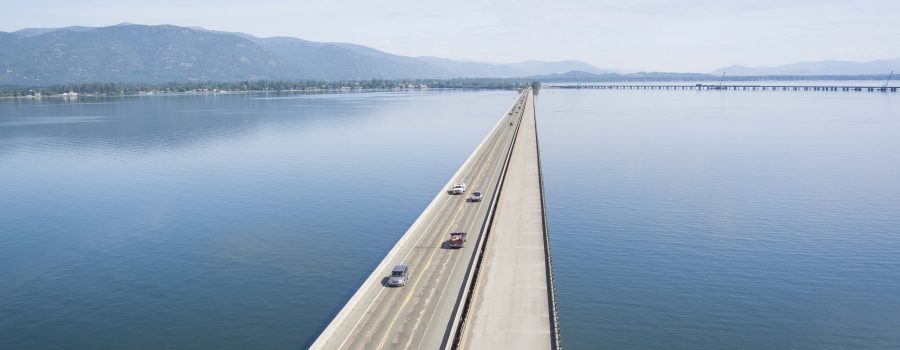Today the Idaho Transportation Board approved $200,000 to start studying replacement options for the Long Bridge on U.S. Highway 95 near Sandpoint.
“Up until now, we have been performing maintenance projects to delay replacing this expensive structure until it reached 100 years old,” District Engineer Damon Allen said. “But as we’ve looked to widen US-95 south of town, we’ve heard from the public that they want us to look at this sooner rather than later.”
The study is expected to start in 2025, with the goal of seeking grant funding to finish the study and design. It would include public outreach and updating environmental evaluations. This would be separate from the ongoing plans to make US-95 safer and capable of handling the increase of traffic between Sagle and Lakeshore Drive, though neither is funded for construction.
The existing bridges—one for vehicles, and the other for pedestrians—were built in 1981 and 1956 respectively. The pedestrian bridge, which originally served vehicles, is no longer able to safely carry traffic and is severely weight restricted.
Previous studies have identified one four-lane bridge with shoulders and a separated bike and pedestrian facility to replace the two existing two-lane bridges. Costs and staging would be identified in later studies, but the initial estimate for building the northbound half of the proposed structure, including a bike and pedestrian facility, is at least $225 million.
“This money will allow staff to begin preliminary planning and pursue grant applications for design,” Allen said.
Repairs on State Highway 64 are complete, and the road between Nez Perce and Kamiah reopened this morning. The highway has remained closed since April 14 after a major storm event caused multiple washouts and structural damage.
“The Idaho Transportation Department and our consultant partners have been working hard to repair and reinforce the highway so that it could be safely reopened this year,” District Engineer Doral Hoff said. “I would like to thank the public for their understanding and patience during the construction.”
The emergency repairs included installation of retaining walls, rebuilding the road base, and paving. Approximately 12 slide locations between milepost 24 and 30 were rebuilt.
For more information, visit itdprojects.idaho.gov/pages/us-64-emergency-repair-project.
The Idaho Transportation Department (ITD) is working to improve customer service and streamline operations by addressing the annual influx of Full Fee commercial vehicle registration renewals in December and January. With thousands of registrations expiring during these two months, the high volume of transactions creates challenges in maintaining timely processing for all customers.
To mitigate this issue, ITD has been offering customers the option to select a different registration expiration month in their Full Fee renewal packets for the past three years. This initiative is designed to evenly distribute registration renewals throughout the year, enabling the Commercial Vehicle Services team to provide faster, more efficient support.
What Full Fee Customers Need to Know
- Action Required for December/January Renewals
If you submit your Full Fee renewal without selecting an expiration month other than December or January, you will receive the following email when your renewal invoice is generated:
In order to serve our customers more efficiently and reduce the extremely high volume of renewals that come in every December and January, please select a vehicle registration expiration month that is not December or January, as indicated on the flyer that was included in your renewal packet.
Please be aware that if a month of expiration other than December or January is not selected, you will be assigned an expiration month for the 2026 renewal period.
If you have a preference on a month of expiration (other than December or January), do not pay the attached invoice. Instead, reply to this message and inform ITD which month you prefer your registration renewal, and a new invoice will be provided.
The email also explains payment options for the current invoice if you choose not to change expiration months at this time.
- Default Assignment for Future Renewals
Customers who do not select an alternate expiration month will automatically be assigned a non-December/January expiration month for their 2026 renewal period.
By spreading the workload across all 12 months, ITD aims to improve processing times and ensure a smoother renewal process for everyone.
For questions or assistance, please contact the ITD Commercial Vehicle Services team at cvs@itd.idaho.gov or (208) 872-3163.
There are 14 open range signs on State Highway 51 from the Nevada border to north of Bruneau that flash when cows are near the highway. Despite these flashing alerts, livestock continue to be hit on this stretch, with four cows struck and killed in the past month alone.
Wilmer Biggs, a transportation technician with the Bruneau maintenance crew, says the highway serves mainly local traffic with drivers who could use a reminder of how collisions can affect them and the livestock. Biggs noted black cows are especially vulnerable to being struck because they are harder to see at night.
“I have come out the next morning after a cow was hit, and the baby is still standing by its dead mom,” Transportation Technician Wilmer Biggs said. “It’s tragic and can be avoided by slowing down and realizing this is an open range area. Drivers need to plan for cattle to be on this highway.”
Tips for driving in open range areas:
- Reduce speed at night: Visibility is limited, and black cows can blend into the darkness.
- Stay alert: Look for reflective eyes or movement near the road.
- Plan ahead: Assume cattle may be present, especially in known open range areas.
Biggs previously transformed advisory signs from a defunct federal radio alert system into flashing open range signs and hopes to convert more in the future. Read more here.
Open range cattle can be found on SH-51 and other Idaho highways year-round. Idaho is an open range state, meaning cattle and other livestock have the right of way. If livestock is hit on an open range, the owner of the animal is not liable for damages to the driver or the vehicle. Drivers may be liable for injuries or death of the animal if found to have been negligent.
Safety is a top priority, especially when it comes to the upkeep of Idaho’s 32 backcountry airstrips. Clear markers are key for helping pilots land safely so they can enjoy the Gem State’s great outdoors. ITD’s Division of Aeronautics is responsible for airstrip maintenance and making sure those markers are easy to see from the sky, and that involves a fresh coat of white paint every five years.
Aero Craftsmen Justin Fort and now-retired Joe Fleck worked with D3 Foreman Jerry Richards to source paint from within ITD. They found out that Central Labs disposes of about 60-70 gallons of paint each year after testing. While it costs Aero $20 to buy a gallon of paint, it costs Central Labs about $200 to dispose of a 5-gallon bucket after testing. It made financial sense for the lab to hand off excess paint to Aero instead of paying to dispose of it. Aero got in touch with Central Labs Senior Chemist Rachel Owens and decided to pick up and start using the paint at the airports.
“We have painted four airstrips this fall, all with sample or test paint that was given to us by Rachel Owens from Central Labs,” explained Fort. “We have been collecting and saving the test paint for over a year, until this August, when we got our new sprayer. It took only two hours to spray the markers and segment circles at each airstrip.”
By thinking outside the box, the two divisions are saving $4,520 a year by using paint that normally ends up as expensive trash.
The Idaho Transportation Department has begun the planning process to improve the South Blackfoot Interchange at Exit 89. The South Blackfoot Interchange has served motorists since 1961. Since then, eastern Idaho’s population and traffic volumes have greatly increased.
At this interchange, Interstate 15 crosses over U.S. Highway 91 on the Fort Hall Reservation. The interchange is in an area of I-15 that is heavily used for commercial, residential and recreational travel. To improve safety and mobility for motorists, it is necessary for ITD to replace the interchange with a design that has increased capacity and meets current standards.
Project plans currently include:
- Lengthening ramps to improve safety.
- Adding a dedicated exit lane to off-ramps to improve ramp operations.
- Adjusting the interchange to accommodate future additional lanes on I-15.
Improvements to this interchange will be developed and designed based on traffic and other technical data, an environmental evaluation, surveying, and input from the public. The planning, design and environmental evaluation stage of the project is expected to be completed in 2026. Construction of the improvements is anticipated to begin in 2030, depending on the availability of further funding. This project is utilizing both state and federal funding.
ITD will provide multiple opportunities for the public to learn more about the I-15 South Blackfoot Interchange project throughout project development, including a public open house and pop-up meetings in early 2025. For more information visit the project website at itdprojects.idaho.gov/pages/i-15-corridor or call 208-252-5553.
Winter weather can be unpredictable, especially on the roads. As a driver, your first and last line of defense is your seat belt. Starting today, more police officers will be on the roads for a statewide seat belt enforcement campaign.
From Friday, November 22 through the end of the month, over 50 state and local law enforcement agencies are partnering with the Idaho Transportation Department’s Office of Highway Safety (OHS) for extra patrols focused on seat belt safety.
During the winter there is a lot that is outside of our control, from the weather to the behavior of other drivers. “What happens in your car is totally under your control, so slow down, drive engaged and buckle up. Let your seat belt do its job of saving your life in the event of a crash,” explained OHS Occupant Protection Program Specialist Tabitha Smith.
If you are in a crash, a buckled seat belt reduces your risk of death by 45% and risk of serious injury by 50%. Last year, 85 people in vehicles who were not buckled up died in traffic crashes.
Data from OHS’s annual seatbelt survey shows that 86% of Idahoans wear their seatbelts. Expect to see more police on the roads in the next few weeks focusing on stopping and educating drivers about seat belt safety, and hopefully saving lives.














